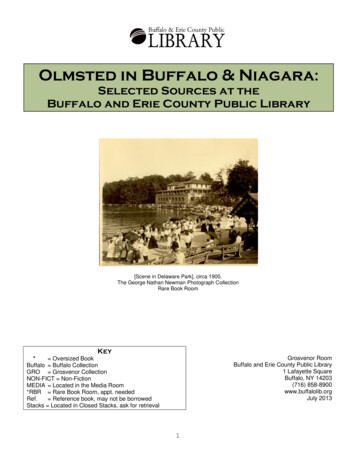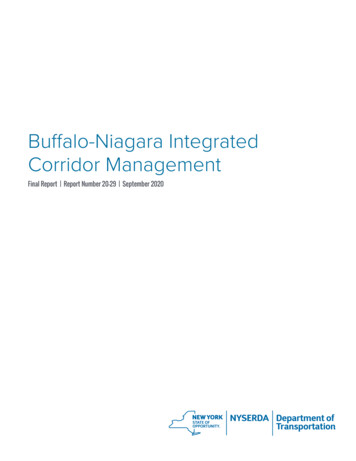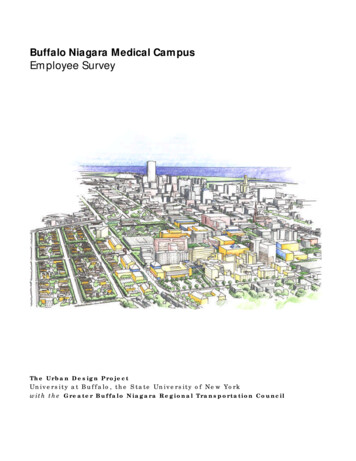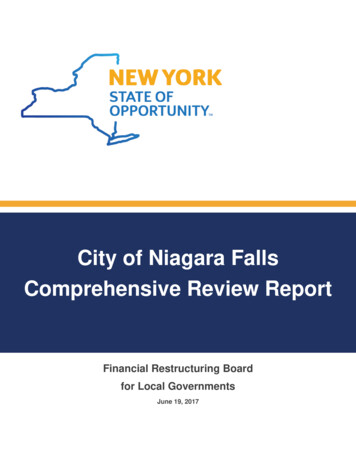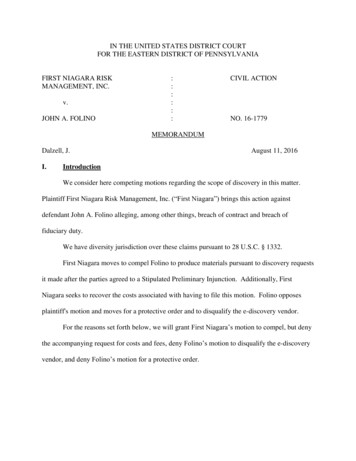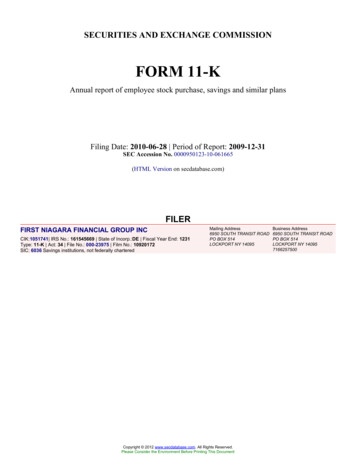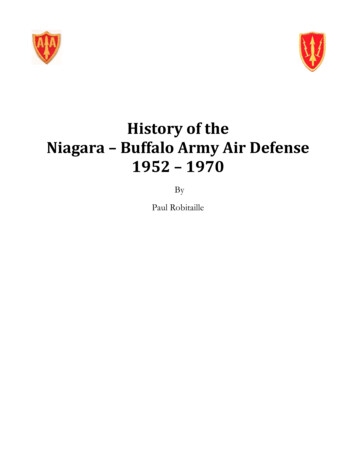
Transcription
History of theNiagara – Buffalo Army Air Defense1952 – 1970ByPaul Robitaille
Introduction:This collection consists of three documents that chronicle the history of the Niagara-Buffalo Army Air Defense between1952 and 1970. The first two documents were articles on this subject written by the author for the Fort Niagara Journal,Fortress Niagara. Part 1, which covered “The Gun Era”, where 90mm Antiaircraft Batteries in the Niagara Regionprovided a limited defense against Soviet bomber attack. It appeared in Volume XVI, Number 2, of Fortress Niagara,issued in December 2014. Part 2, which covered “The Nike Missile Era”, where more capable Nike Guided Missilesreplaced the dated antiaircraft guns, appeared in Volume XVI, Number 3, which was issued in March of 2015.The third document, titled “Niagara-Buffalo Army Air Defense Command History”, examines the history from adifferent perspective, describing the history of the top level command structure and the antiaircraft battalions thatcomprised the Niagara-Buffalo Army Air Defense. Included in this document are details obtained from several veteranswho served in the 1st Missile Battalion, 4th Artillery during the Nike period, and related newspaper articles that ran in theNiagara Falls Gazette, Buffalo Courier Express, Lockport Union Sun and other papers of the Niagara-Buffalo regionand beyond. The intent of this document was to create a framework for veterans of the units who served in theNiagara-Buffalo Army Air Defense to have a means to share their photos and memories with fellow veterans andresidents of the Niagara-Buffalo area.Copies of this collection have been distributed to Niagara-Buffalo area libraries and historical societies, and to thosecontributing veterans who have contributed photographs or reminiscences for their retention and sharing with others. Itis the authors hope that this document will help to bring forward a richer collection of personal recollections andphotographs from this period of history. Readers who have additional material on this subject such as recollections,photographs etc, may contact the author at the following address: robitaille60@gmail.com.Respectfully,Paul RobitailleDistribution:Niagara Falls Public Library – Local History DepartmentNiagara County Historical SocietyBuffalo & Erie County Public Library – Local History DepartmentBuffalo History MuseumOld Fort Niagara AssociationNew York State Military Museum and Veterans Research CenterU.S. Army Historical Institute, Carlisle, PennsylvaniaVeterans who have contributed material to this research project
Fort Niagara and the Cold War Army Air Defense of Western New YorkPart 1 – The “Gun” EraBy Paul Robitaille24 March 2015Background:On 30 September 1952, the Niagara Falls Gazette announced arrival of the 2 nd Antiaircraft Artillery Group,U.S. Army, from Fort Devens, Massachusetts.1 The convoy of vehicles, several miles long, loaded with morethan 1,000 soldiers and equipment arrived in Model City, New York, shortly after 10:00 a.m. to a rainy skyand 40 degree temperatures.2 On 1 October, heavy M4 tractors and 90mm antiaircraft guns arrived inNiagara Falls via rail.3 Why were these troops and antiaircraft artillery weapons being deployed to the NiagaraRegion?In the aftermath of World War 2, several painfully learned lessons remained fresh in the U.S. Government’scollective memory: surprise attack by a hostile aggressor seemed a likely event in any future military conflict;an effective air defense, consisting of interceptor aircraft and ground based antiaircraft batteries, made anypenetration of the nation’s airspace costly; and, given the massive destruction modern weapons were capableof inflicting on industrial facilities and population centers, without an effective air defense the United Statescould be vulnerable to disabling surprise attack.4These lessons resulted in a post-war United States National strategy of abandoning its tradition ofisolationism in favor of a collective national security achieved by: “(1) support for the United Nations, (2)forward deployment in both the Atlantic and Pacific, (3) relatively strong Air and Naval Services, (4)continuation of the U. S. monopoly of atomic weapons, (5) a small Regular Army and (6) a large, wellorganized reserve of citizen soldiers”.5A series of international events in the post war years led to the start of what was later called “The Cold War”,beginning with the fall of Czechoslovakia in 1948 to a bloodless Communist coup d’etat. This was followed bythe Berlin Blockade which started 24 June 1948 and ran through May of 1949; President Truman’s reinstitution of the draft in May of 1948; and the detonation by the Soviet Union of its first atomic bomb on 29August 1949. As if these events were not enough to warrant concern about our National security, in Octoberof 1949 China became the Communist Peoples Republic of China; and in June of 1950, Communist NorthKoreans, with support from Communist Chinese and the Soviet Union, invaded South Korea starting theKorean War which ran until July of 1953.World events produced an era of uncertainty. Without clear knowledge of what the Soviet Union’s objectiveswere and what offensive capability they possessed, coupled with the lack of transparency between the Eastand West, the senior leadership of the United States Government became concerned about our nationalsecurity and felt the need to demonstrate a national commitment to readiness. This need was underscoredwhen the Soviets flew four TU-4 “Bull” Strategic Bombers, which looked very much like B-29’s, in a 1949public display witnessed by the West. It was no coincidence. The over flight by the Soviet Air Forcecontained three United States B-29 bombers which had been engaged in bombing Japan in World War 2 but,because of battle damage, were forced to land in the Soviet Union, and had subsequently been repairedunilaterally by the Soviets (unbeknown to the United States). Even more significantly, the Soviets had reverseengineered and built one additional B-29 cloned aircraft! The discovery was significant because the TU-4provided the Soviets a strategic bombing capability. The Soviets now possessed the ability to deliver anatomic bomb to Chicago or Los Angeles on a one way mission.6Numerous study groups were convened to address the subject of the air defense of the United States. Thenewly created Department of the Air Force, (established as a distinct branch of the armed forces in 1947),1
and the Army struggled extensively over who would have overall command of gun air defense. Ultimately aframework was established between the two services for operational control which was documented in theCollins – Vandenberg Agreement of July 1950. The agreement specified the limited conditions under whichthe appropriate Air Defense Commander would control the fire of antiaircraft weapons. 7 While theagreement had been signed, the Army maintained that it significantly limited the ability of the Army AirDefense Commander to provide timely and effective response.In the fall of 1948, as the buildup of military forces commenced, plans were developed for deployment of theavailable Army Antiaircraft units for the defense of the U.S airspace. A postulated list of targets was preparedand allocations of defensive forces were assigned as appropriate, depending on the strategic value of thetarget. In the initial deployment plan, the Niagara – Buffalo region was to receive three Antiaircraft Artillery(AAA) Battalions, “to the extent that appropriate units are available”.8 It was realized at the time this planwas prepared that the resources being deployed would not eliminate the threat. The best kill-expectancy thatcould be attributed to an AAA based defense was from 20-60% depending on the number of guns defendinga given target.9Why was Niagara-Buffalo on the target list? Was it because of the Robert Moses Power Station? No,because the collapse of the Schoellkopf Power Station in Niagara Falls, which begot the need for the RobertMoses Power Station, did not happen until 1956 and construction on the Robert Moses Power Project wasnot approved by Congress until 1957.10Apart from being a major industrial area, what other reasons would make the Niagara – Buffalo region astrategic site warranting air defense? While it is not given as a specific reason in unclassified reports, duringWorld War 2, and for some time afterwards, there were a number of facilities in Buffalo, Lackawana,Lockport, Niagara Falls, and Tonawanda, New York, which were involved in supporting the ManhattanProject. The codename “Manhattan Project” was given to the complex government – industrial organizationthat developed and produced the Nation’s first Atomic bombs during World War 2. Recall a key item on thelist of post-war collective security elements – “maintain the U.S. monopoly of atomic weapons”. By 1950,the United States was no longer the only nation possessing atomic weapons, but we most likely were the onlyone with a national infrastructure that knew how to successfully produce more of them. Later in time, anumber of these Western New York firms also supported the Atomic Energy Commission.11 According toan appendix from an unavailable study, prepared many years later by the Center for Disease Control, thecontracted tasks of these companies included processing uranium tailings, manufacturing uranium rods andslugs, shaping and engineering uranium rods and plutonium carbide pellets, and managing the long termstorage of uranium processing waste products.12The critical elements of the atomic weapons national infrastructure, particularly those facilities located in themore northern and coastal regions of the United States were considered to be strategic resources requiringimmediate protection. Prior to the advent of intercontinental and theater ballistic missile threats, it wasbomber aircraft delivered atomic weapons that the nation was defending against. Due to the operationalrange constraints on the aircraft of that period; one-way “over-the-pole” missions were the only optionavailable to the Soviets if they wanted to strike the United States. The Niagara-Buffalo region was a likelytarget.Army Antiaircraft Artillery Command Organization:Three regional Army Antiaircraft Commands (ARAACOMs) were established; Eastern, Central and Western.EASTARAACOM consisted of three brigades. The Niagara–Buffalo region was be included in the 56th AAABrigade which was activated 28 June 1950 at Camp Edwards, Massachusetts. This Brigade also included unitsproviding the AAA defenses of Boston and New York City.13 The Niagara Region Army Air Defense unitswere organized locally under the 2nd Air Defense Artillery Group, commanded by Colonel Adam S.2
Buynoski.14 After arriving in the Niagara Region, the 2nd Air Defense Artillery Group was initially based atModel City, in the former Lake Ontario Ordnance Works.The 2nd Air Defense Artillery Group was comprised of the 44th AAA (Gun) Battalion, and the 606th AAA(Gun) Battalion, both were Regular Army units. The 336th AAA (Gun) Battalion, a New York ArmyNational Guard unit based in Rochester, NY, mobilized for Federal service 15 May 1951 – February 1953,was also involved, but only for a short period. The 606th relieved the 336th AAA (Gun) Battalion in Februaryof 1953.15 Figure 1 depicts the distinctive unit insignia of these battalions.44th AAA (Gun)Battalion RA106th AAA (Gun)Battalion NYARNG336th AAA (Gun)Battalion NYARNG606th AAA (Gun)Battalion RAFigure 1. Distinctive Unit Insignia (DUIs) from Niagara-Buffalo based Antiaircraft Artillery UnitsIllustration is courtesy of the author’s collectionThe specific locations of “Gun Era” Niagara - Buffalo Army Air Defenses evolved over time. The initialdefense was Battery “B” of the 44th AAA (Gun) Battalion at Fort Niagara. Eventually the 44th mannedbatteries at the Tuscarora Indian Reservation, one in Lewiston and one, possibly two batteries on GrandIsland. In February of 1953, the 606th AAA (Gun) Battalion was activated and manned batteries at Lewiston,Wheatfield, near Sanborn, and on Grand Island. In 1955 with the conversion of the 44th AAA (Gun)Battalion to a Nike Missile Battalion, the 606th relieved the 44th AAA (Gun) Battalion at their TuscaroraIndian Reservation and Grand Island sites. In addition to these prior sites, a temporary installation wasestablished on 62nd Street in Niagara Falls, near the then planned 62nd Street School. Fort Niagara served asthe Headquarters for the 2nd Air Defense Artillery Group and was the location chosen for the AntiaircraftArtillery Operations Center (AAOC). Precise records of which battery of the assigned AAA (Gun) Battalionsoccupied a given site, and for what period, are unclear, but according to the limited Army records available,during the “Gun Era” only two Regular Army Gun Battalions were assigned for the entire 1953-1955 timeperiod. Given the sparse records, to the best of the author’s knowledge, the list of locations occupied and theunits assigned are as given in Table I.The NYARNG augmented the Niagara-Buffalo Defense in May of 1957 by adding a “Special Security Forceconsisting of 106th AAA Battalion (90mm gun) with Battery “B” on Lockport Road in Wheatfield, andBattery “C” on Ransom Road on Grand Island. The article goes on to say that these two NYARNG siteswere originally manned by the 44th AAA (Gun) Battalion which moved into area Nike Sites two years ago,and that the 106th assumed responsibility for the Wheatfield site in September of 1955 and the Grand IslandSite one year later. 16. “C” Battery of the 606th clearly manned the Wheatfield site and erected “nearly 20buildings” at the site” as reported in a Niagara Falls Gazette article dated 20 February of 1956, page 11.Another Niagara Falls Gazette article dated 18 May 1956, states that the 336th AAA (Gun) BattalionNYARNG had a battery on Grand Island and that the 106th AAA (Gun Battalion) had a battery located inLockport. It is unknown if the NYARNG sites were additional units occupying the same sites occupied bythe 606th AAA (Gun) Battalion or if these were different physical locations. The 606th AAA was still active asa “gun AAA unit” in the Niagara-Buffalo Army Air Defense until they were deactivated in December 1957.3
Table I. Cold War Army AAA Gun Sites in the Niagara RegionSiteFort NiagaraStaley RoadLocationYoungstown, NYGrand Island, NYSpecific location unknown,possibly also at Staley RoadLewiston VillageGrand Island, NYNorth 5th Street, Lewiston, NYTuscarora IndianReservationNear the intersection of Mt. Hopeand Green RoadsWheatfieldNE of the intersection of Walmore& Lockport Roads, near NiagaraFalls Air Force BaseFort NiagaraYoungstown, NYNote: Data for above table was compiled from multiple sources.17Units Assigned44th, Battery BBattery “A” of the 606th wasreplaced in April 1955 by Battery“B” of the 44th. Battery “D” ofthe 606th was reported as manningthis site in May of 1957, probablyafter the 44th assumed commandof the Grand Island Nike Site.44th and later replaced by 606thBattery “A” of the 44th replaced inApril 1955 by Battery “B” of the606thBattery “D” of the 44th wasreplaced April 1955 by Battery“A” of the 606thBattery “C” of the 606thHQ 2nd AAA Group & 44thWhile unit sizes varied somewhat, a typical AAA (Gun) Battalion was comprised of a headquarters batteryand four firing batteries. The Headquarters & Headquarters Battery, designated as HHB, included theBattalion Commanding Officer and his staff and a firing battery. Most AAA (Gun) Battalions included up tofour additional firing batteries, each one designated alphabetically (“A” Battery, “B” Battery etc.). Each firingbattery had a Battery Commander, four gun crews, a fire control crew and support functions such as cooksetc. Staffing at the firing batteries varied slightly depending on the alert status of the unit at that time andmany Cold War AAA Battalions deployed at less than their allocated manpower.The troops were initially quartered in tents while arrangements were made to occupy several of therefurbished barracks at Fort Niagara. As the gun batteries were deployed, the crews occupied “JameswayHuts”, a wooden framework covered by insulated canvas, and in some cases, metal-shelled “Quonset Huts”.These shelters were located adjacent to their gun emplacements at the deployed batteries.18 They were lessthan ideal “homes” for the troops, particularly in the winter. Over time, several barracks at Fort Niagarabecame available to the troops which made living accommodations much more comfortable.19On 15 February 1953 the first public “Open House” of the Niagara Region AAA defenses was hosted by“D” Battery of the 44th AAA Battalion at their gun battery on the Tuscarora Indian Reservation.20Description of the AAOC:The Fort Niagara-based AAOC, shown in Figures 2 and 3, was the “manual” tactical command center for thedeployed gun batteries and was under the command of the 2nd AAA Group Commander.21 The AAOCtypically received long range target information from higher authority or search radars within their command.A close look at the AAOC status boards behind the right most soldier in Figure 2 confirms that at the time ofthe photo, (15 May 1953) the 2nd AAA Group had two TPS-1D search radars, one for the 44th AAA4
Battalion, and one for the 606th AAA Battalion.22 If properly sited and maintained, the AN/TPS-1D had aneffective surveillance range of about 100 miles. It is not known where these two radars were sited, but it isknown that one veteran who served at the Millersport Nike Site claimed to be the AN/TPS-1D person forthe Buffalo Defense in 1957 – 1960.23 By 1953 it is recorded that long range air surveillance was beingprovided by AN/CPS-6B search radars (which had an effective range of 165 miles),24 operated by the 763rdRadar Squadron, U.S. Air Force, which was based at the former Lockport Air Force Station, located near thesmall hamlet of Shawnee.25 The long range surveillance information enabled the AAOC to perform its roleof collecting, evaluating, and disseminating tactical threat information to the gun batteries and providing firedirection including, when deemed necessary, the restriction of fire. Under normal conditions, the deployedgun batteries would be assigned specific targets, and authorization to fire or hold fire. In turn, the gunbatteries would provide the AAOC with the readiness status of the battery, acknowledgement of assignedtargets, the status of the target engagement and their readiness to accept new targets. In the early 1950’s theinformation link between the AAOC and the gun batteries was provided via voice radio or telephone.Figures 2 & 3. Two views of the 2nd AAA Group AAOC at Fort NiagaraArmy photographs dated 15 May 1953. Image courtesy of National Archives & RecordsAdministration (NARA)Description of a Gun Battery:Each gun battery was equipped with four 90mm antiaircraft guns which were controlled by a radar-equippedFire Control System. The battery had diesel generators to power their equipment so it was not disabled ifcommercial power was interrupted.Guns - Two types of 90mm guns were used in the Niagara – Buffalo Region. Initially, the batteries wereequipped with the older 90mm M1A1 gun mount, but subsequently were upgraded in 1957 with the moremodern 90mm M2 mount.26 Both guns are shown in Figures 4 and 5.27 The M2 gun mounts differedprincipally in the addition of metal shields for crew protection and an automatic fuze setter-rammer.Field emplacements were constructed for each gun. The layout of the gun battery was typically in a square.Each gun was sited equidistant from the next gun in the square, at a distance of between 35 and 50 yards.The specified field emplacement was as shown in Figure 6, although the author has seen photos ofemplacements in other Cold War AAA batteries that were of a more permanent nature. The fire control5
radar van was located behind the guns, to minimize the parallax correction needed for each gun. Onceemplaced, the guns were leveled, surveyed and aligned with the Fire Control System.Figures 4 & 5. 90mm Antiaircraft Gun M1A1 (left) and M2 (right)Photographs courtesy of NARAFigure 6. 90mm Antiaircraft Field Emplacement DetailsFigure courtesy of War Department Field Manual 5-15, Field Fortifications, dated February 19446
Figure 7 shows the four 90mm M1A1 guns of a 606th AAA (Gun) Battalion battery in their emplacements,the gun crews, the cableways between the guns, and the M33 Fire Control System and the diesel powergenerators.28Figure 7. Wheatfield Gun Battery - 90mm M1A1 GunArmy photograph dated 15 May 1953. Image courtesy of NARAAmmunition - The M1A1 and M2 90mm guns both used the same ammunition. The 90mm M71round,shown in Figure 8, was classified as fixed ammunition, meaning that the cartridge case containing the sevenpound propelling powder charge and the shell were combined into a complete round. Each round weighedapproximately 44 pounds and was approximately 37 inches long. High explosive (HE) shells, each pre-loadedwith a two-pound charge of trinitrotoluene, (TNT), were used against antiaircraft targets. The blast effect andshrapnel created by the exploding shell are what caused aircraft damage.The HE shell was fitted with either a mechanical time fuze or proximity fuze. The mechanical time fuze wasmanually set by a member of the gun crew on the M1A1 Gun before loading the round into the gun. On theM2 guns, the mechanical time fuze was automatically set by the fuze setter-rammer. Time of flight from thegun to the future position of the target was continuously calculated and updated by the Fire Control Systemand provided to the guns electrically.The proximity fuze, (code named “VT” for variable time), was a late World War 2 invention. It controlledthe time of projectile detonation by using an onboard radio in the projectile which worked like miniatureradar. The fuze sensed the range to the target and automatically detonated the projectile at the optimumdistance from the target, (approximately 60 feet).29 The “VT” fuze greatly improved the effectiveness of AAgunfire. Both types of fuze were armed when the gun was fired and the projectile rotated down the barrel ofthe gun. The 90mm round had an effective vertical range of 11,273 yards when using the mechanical timefuze and 12,100 yards with the VT fuze. The horizontal range was 13,000 yards.307
Figure 8. 90mm High Explosive Antiaircraft Round M71Photograph courtesy of War Department Technical Manual TM-9-372, 15 November 1944The guns typically operated in “automatic” mode which meant that the bearing and elevation of each gun wascontrolled by servo-controlled power drives driven by electrical signals from the Fire Control System. Thegun mounts could also be traversed and elevated manually if the power drives failed. Indicator panels at theelevation and bearing operator positions on the gun mounts allowed the gun crews to manually position thegun as ordered by the Fire Control System. Per Army guidance issued in 1943, a seven-man crew wasstationed on the gun mount; the Gun Commander and a six-man ammunition handing crew were also part ofthe gun crew but worked adjacent to the gun mount.31 Adjustments to the number of personnel on the guncrews were made over time. The M2 gun was able to operate with a smaller crew due to the automatic fuzesetter. A well practiced gun crew could fire between eighteen and twenty-four rounds per minute.Fire Control System - The 2nd AAA Group was equipped with the latest Antiaircraft Fire Control System,(AAFCS), available in 1953 which was the M33, see Figure 9.32 Under Army direction, Bell Laboratories andWestern Electric, commenced development of the AAFCS M33 in 1945 and production followed in 1950. Atotal of 645 of these systems were produced. The AAFCS M33 was a mobile, trailer-based, integrated,electromechanical fire control system and had the ability to direct both 90mm and 120mm gun batteries.Inputs required by to the AAFCS M33 were straightforward; electrical power, long range early warninginformation and meteorological data. 2nd AAA Group personnel were trained on the AAFCS M33 system atFort Bliss, Texas, and Fort Devens, Massachusetts.33Unlike earlier AAFCSs, the M33 was equipped with its own acquisition radar, shown in Figure 9, which couldrotate 360 degrees and could elevate from zero to 9 degrees. It was capable of doing a 360 degree scan at 10,20 or 30 times a minute (as selected by the operator) and could acquire targets at a range of up to 120,000yards (68 miles). The acquisition radar was located approximately 250 feet from the radar trailer and wasconnected to the radar van by cables.34Figure 10 shows the 606th AAA (Gun) Battalion at the Wheatfield site located near Sanborn, New York, justNorth-East of the junction of Walmore and Lockport Roads. Clearly visible are the Radar Trailer M242 withthe tracking radar antenna on top, the Maintenance and Spare Parts Trailer M244 just behind, and in thedistance, the barrels of three of the four 90mm antiaircraft guns of the battery can be seen. The soldiers inthe foreground are probably the fire control crew which manned the radar consoles in the adjacent radartrailer.358
Figure 9. M33 Fire Control System Acquisition RadarPhoto credit: A History of Engineering and Science in the Bell System – National Service in War andPeace (1925-1975), page 361.Authors Note: Not seen in the photograph is the M33 Fire Control System Acquisition Radar. It is possible that the AAAGun Batteries at Niagara were using externally sited TPS-1D or the Air Force AN/CPS-6B radars for long range targetacquisition. A close look at the original of the AOCC illustration in Figure 2, lists TPS-1 D radar for the 44th AAABattalion, and one for the 606th AAA Battalion on the status board behind the right most soldier. The pictures in Figure 2and Figure 8 were both taken in May of 1953.Figure 10. Wheatfield Gun Battery – AAFCS M33 Radar Trailer M242 and CrewArmy photograph dated 15 May 1953. Image courtesy of NARAThe M242 Radar Trailer served as the gun battery Command Post. As shown in Figure 11, it contains theradar cabinet, together with a switchboard cabinet, the early-warning plotting board, the tactical-controlconsole, and the tracking console, which were all manned positions when the system was operating.369
The Switchboard Cabinet provided separate, two-way, circuits for voice communications between the radarvan and 1) the gun captains at each gun mount; 2) early warning information sources; and 3) higher authorityin the remotely-located AOCC.37Figure 11. M242 Radar Trailer Cutaway ViewIllustration credit: US Army M33 Training ManualEarly-warning information on friendly and hostile aircraft would be manually plotted out to a maximum of250,000 yards on the Early-Warning Plotting Board, located just behind the Tactical-Control-Console, whichserved as the control center for the gun battery. Having been assigned a target, the radar operator wouldselect the assigned target from any other aircraft returns (or other returns such as clouds etc.) on the radardisplay and initiate automatic tracking of that target by the fire control system as long as radar contact of thetarget was maintained. Once a track was established by the target tracking radar, target horizontal range andelevation information was displayed on electro-mechanical automatic plotting boards on the Tactical-ControlConsole. A third panel provided the fire control computer operator the ability to select the type of trackprediction desired for a given target as well as a means to adjust the level of track smoothing needed so thefire control computer could generate a fire control solution. Finally, the Monitor and Control Panel on theTactical-Control-Console provided the battery commander the summary status of the gun battery, as well asthe detailed status of the batteries’ guns, fire control computer, and target track. The panel also includedcontrols which allowed the Battery Commander to sound the alert siren, and issue “fire” or “cease fire”orders to the battery.Using the Target-Tracking Console, three radar operators would control the acquisition and target trackingradars. Displays on the console provided long range and precision track displays, as well as bearing and10
elevation views of the track. Control switches permitted the radar operators to monitor the health of theradar and make necessary adjustments to improve the quality of the track as well as counter the effects ofradar jamming by the enemy.The tracking radar antenna itself was located on top of the radar trailer. Once the tracking radar established atrack on a target, the tracking antenna would be driven by an electronic servo system which automaticallykept the antenna pointed at the target as long as the track was maintained. A periscope was also attached tothe radar antenna and positioned such that an operator inside the radar trailer could view the target beingtracked and confirm the tracked target was a hostile aircraft. Since the tracking radar had an operationalrange of approximately 120 miles, the periscope was seldom an effective method for target identification atlong distance. In 1954 Identification Friend or Foe (IFF) subsystems were provided and to the Army AirDefense Command and subsequently fitted to the fire control system’s acquisition radar to provide enhancedtarget identification at longer range.Technical Support - The gun batteries of the Niagara – Buffalo Army Air Defense mission were supportedby an Army Field Support Facility initially located at Fort Niagara, near what was then the base movie theatre.The facility later moved to an aircraft hangar on Walmore Road in Niagara Falls, near the former Bell AircraftFacility, and eventually occupied most of the former Naval Air Reserve Station on Porter Road in NiagaraFalls. The support facility was staffed by regular U.S. Army Ordnance Officers and Department of the Arm
1 Fort Niagara and the Cold War Army Air Defense of Western New York Part 1 - The "Gun" Era By Paul Robitaille 24 March 2015 Background: On 30 September 1952, the Niagara Falls Gazette announced arrival of the 2nd Antiaircraft Artillery Group, U.S. Army, from Fort Devens, Massachusetts.1 The convoy of vehicles, several miles long, loaded with more



